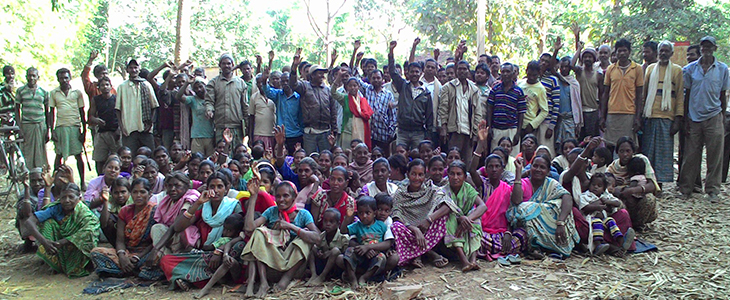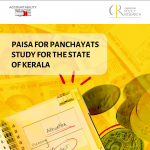
Understanding ‘Inclusive Development’ in New States – Jharkhand and Chhattisgarh
16 September 2016
In June 2014, we embarked upon a research project in the twin states of Jharkhand and Chhattisgarh in India. While we were cognizant of the depths that the study would take us to, I believe having worked on it for more than two years now, it can safely be said that there is a plethora of information and a whole lot of knowledge that we have attained.
To give a background, Chhattisgarh and Jharkhand are two mineral rich states in India which were carved out of Madhya Pradesh and Bihar, respectively. Over the years, there has been a deep interest in the creation of smaller states to alleviate the problem of spatial inequalities of the older, larger states by improving governance and administration, thereby, boosting developmental outcomes. These two states, created in November 2000, started out with broad similarities such as their significant Adivasi populations, presence of large tracts of forest land and their mineral wealth. However, over time, it was realised that the two states have actually embarked upon very distinctive trajectories relating to growth, poverty reduction and outcomes for social welfare programmes. In these respects, Chhattisgarh seems to have done better than Jharkhand on almost all accounts which seek to quantify ‘development’.
To understand and study the two states, we chose to work on two themes: the extractive regime or mining and the Public Distribution System (PDS). We found that Chhattisgarh has aggressively pursued the reforms process for the PDS, making it a force to reckon with and providing us an interesting contrast to Jharkhand’s PDS or more broadly its social welfare programmatic outcomes story.
While Chhattisgarh has improved the delivery of subsidized food grains under the PDS tremendously after the implementation of reforms, cutting leakages by 82% between 2004-05 and 2011-12, Jharkhand’s cut down leakages from the PDS by 48% during the same period.
Speaking of mining, both the states have actively pursued their interest in mining with an emphasis on modernisation based on mega industries and development. However, even though mining raises revenue and is important for economic growth, it raises significant and often disconcerting questions of dispossession, environmental transformations and acts of resistance, known as the social costs of mining. How the two states deal with these social costs of mining, either through direct investments from mining royalties or through the implementation of their own set of welfare agendas is something which we have aimed to understand through this research.
Going beyond conventional approaches, this research uses a political settlements approach characterising the political arrangements between various social groups in a society – between political and business elites and between elites and other socio-economic groups. These need to be stable at a certain point in time and influence the distribution of benefits from the institutional arrangements. A settlement in that sense, can be said to be successful when it is able to provide an atmosphere where there might not be an absence of conflict, rather there is a resolution or management of distributive conflicts.

This research indicates that the differences in outcome in development between the two states, Jharkhand and Chhattisgarh, depend on their respective political settlements. While Chhattisgarh’s political settlement is marked by relatively higher levels of elite cohesion in political competition, higher bureaucratic autonomy and a higher state capacity in terms of responsiveness to the needs of the industry along-with a more centralised system of rent-seeking in place in the state; Jharkhand by contrast suffers from a lower level of elite cohesion in political competition with a multitude of regional parties, low bureaucratic autonomy and state capacity with multiple decentralised transactions for rent-seeking.
What also comes across as a stark difference is the fact that while Jharkhand witnesses strong, more peaceful networks of civil society while Maoist resistance is more dispersed; Chhattisgarh, has uneven networks of civil society with a concentrated presence of Maoists in the state and a high-profile state-sponsored vigilante army being used to suppress the resistance.
The political settlement in Chhattisgarh has undoubtedly enabled the promotion of service delivery of welfare programmes, which is not something witnessed in the case of Jharkhand. Chhattisgarh’s better functioning PDS is a major factor for the ruling coalition’s bid for legitimacy and the management of social costs of mining. The same, however, is not true for Jharkhand’s political settlement where the welfare system is broken leaving the ruling elites relatively more exposed to criticism around mismanagement.
The management and facilitation of mining activities can also be said to have been better promoted because of the political settlement of Chhattisgarh in contrast to that of Jharkhand. However, having said this, the continued levels of corruption and brutal dealings with protestors in Chhattisgarh raises serious questions around transparency, accountability and those around political inclusion.
It is, therefore, not feasible to conclude whether Chhattisgarh has done better than Jharkhand in promoting inclusive development or that it can be viewed as a better performing example amongst low-income states. This research, thus, goes to show that even though the creation of smaller states may be advocated for the promotion of spatial equality, the actual narrowing of inequalities would to a large extent be dependent upon the political settlement of the regions in question.
Further reading:
Chhotray, V., Bahuguna, V. and Adhikari, A., 2016 ‘Newly created Indian states and inclusive development: The sub-national political settlements of Jharkhand and Chhattisgarh’. ESID Working Paper, forthcoming
Vidushi Bahuguna is Research Associate at Accountability Initiative working primarily on the political settlements approach in understanding development . She is also a part of the PAISA project in Chhattisgarh. Prior to this, Vidushi was working as a researcher with a UNICEF project in Chhattisgarh focusing on women’s nutrition and health.





